- Residents of Kinangkung rely on water from the surrounding forest to power their homes.
- The microgrid is the consequence of years of a focused drive by a community to protect its ecological wealth.
- Kinangkung is just one sign that microgeneration is beginning to concentrate minds in the archipelago’s outlying areas.
Out over the corrugated roofs and laundry lines dotted about Kinangkung village, forest canopy begins to fade into the foothills of Sumatra’s most active volcano.
Here around 30 kilometers west of Mount Sinabung’s ashen slopes some 80 families have quietly been taking care of their surroundings, passing conservation methods down generations through a history that has taken in war and modernization.
Livelihoods in most rural communities in Indonesia have grown as the tree cover has dwindled. Tranches of the forest in nearby Sibolangit district have been razed to plant the ubiquitous oil palm tree. But here in the Barisan Mountains on the border with Aceh province, generations of families have been raised to resist such pressures.
Today the community even has a direct stake in conserving their environment – the forest keeps the lights on.
“We don’t need to exploit common resources,” 69-year-old village leader Bolang Bukit told Mongabay in April. “What we need … is that the forest is maintained.”
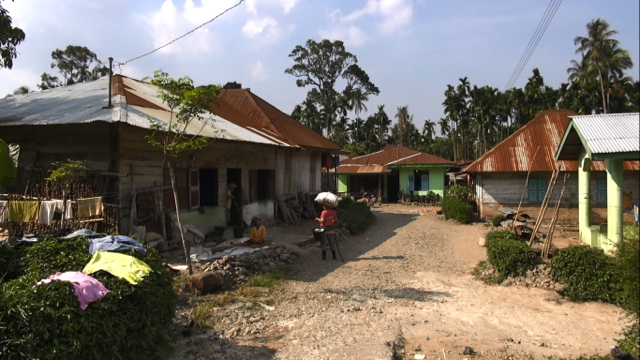
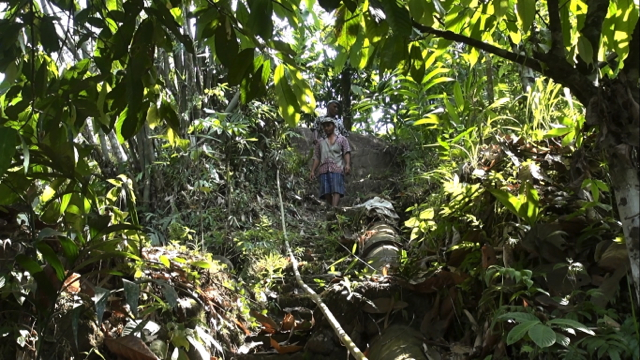
Data on electrification in Indonesia are patchy but estimates indicate around a third of the country’s 250 million people live with no access to a mains supply. New president Joko Widodo plans to add 35 gigawatts of capacity by 2019 to meet an estimated 9 percent annual increase in demand. The lion’s share of this new capacity will come from the construction of cheap coal-fired plants. In the meantime the state-owned grid is struggling to cope with rising power demand.
There are signs that microgeneration is beginning to concentrate minds in the archipelago’s outlying areas, far removed from the nearest power company transformer.
Sumba, an arid and impoverished island in Indonesia’s neglected east, hopes to harness its plentiful sunshine to become self-sufficient through photovoltaics, a method of converting solar energy into direct current electricity. Here in the soggier highlands of North Sumatra, the people of Kinangkung are tapping the forest’s water.
“The resources in there provide our electricity,” Bolang says, grinding up a betel nut.
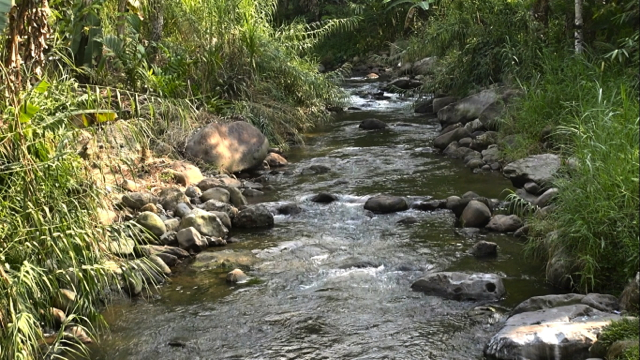
It’s a system that was borne out of meetings among village elders 25 years ago. Community leaders have gathered here for years to mull over various problems, such as reducing the forest-floor clearance caused by trampling feet. Keeping the lights on after the sun went down was higher up the agenda. Bolang says there was no shortage of suggestions for how to power the village, but in the end the elders voted to make the best use of what they had.
Testing the waters
While the electricity scheme was hatched a generation ago, the village’s Silent Spring ideals were perhaps partly formed in less-quiet times. Bolang says Indonesian independence fighters would use the village to hide from colonial Dutch skirmishers, the men lying prone before springing guerilla attacks. Bolang says the focus at the time was on keeping the forest lush to protect the fighters’ cover.
The economy of Kinangkung today, like much of North Sumatra, revolves around the more-metronomic rhythms of agriculture. Cabbage, chilies and oranges are planted, then uprooted or picked before being prepared for markets. Most go to the nearest highland towns, Berastagi and Pancur Batu. Other families in the village have plied a trade in gemstones, leaving their village’s wood-shuttered homes to unearth the marbled gems before taking them to trade in Medan, a six-hour drive away.
Power consumption here is likely to accelerate as incomes slowly improve. But village leaders believe they can adapt and scale-up supply as demand for electricity rises.
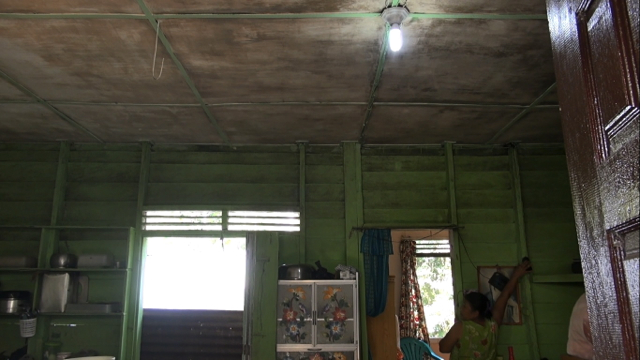
Diversion tactics
Putra Alam Tarigan operates the village hydro generator. He watches diverted water run down from the forest past filters fashioned locally from bamboo through a 15-kilowatt turbine. This generates enough electricity for energy-saving lightbulbs and TVs pumping out sinetron episodes and half-hearted current affairs talk shows.
When electricity demand reaches maximum capacity, Putra can simply replace the Pelton turbine with one double the size.
“If all goes well it’ll run for 20 years without a hitch,” he says.
The result is a commons supply of electricity sufficient not just to keep the lights on in Kinangkung. It powers neighboring villages as well.
“We don’t need to bother about having light in the village,” Bolang says. “It’s not something we worry about because we have lau power.”
Lau is the word for “water” in Karo, the language of the mostly Christian tribe in this part of Sumatra. Bolang continues to go to work on the betel. It’s good for your teeth, he says, obviously incorrectly.
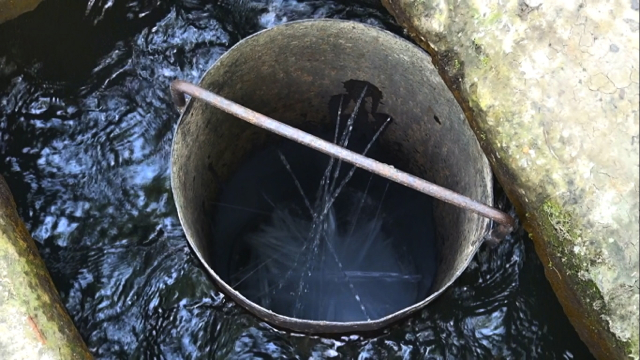
On the grid
The benefits of the microgrid should not be underestimated. In other parts of the region, households pay hundreds of thousands of rupiah per month for electricity.
New floating tariffs for electricity introduced by the government this year have created new inflationary pressures. In Kinangkung no one need fork out for expensive and wasteful small-scale diesel generation – they pay just Rp20,000 a month, not even $2.
But the relationship around Kinangkung between people and forest runs deeper than a bargain over electricity – the microgrid is the consequence of years of a focused drive by a community to protect the forest. The giant altingia excelsa evergreen and the smaller flowering schima wallichii tea trees continue to flourish in this part of the highlands.
Nuraini Beru Tarin, a Kinangkung veteran, hopes this community cohesion will be consolidated as the next generation of leaders, like her son, grow up.
“I keep reminding him about how his bolang and nondong [grandparents] took care not to ruin the forest – how they went about hunting rabbits,” she tells Mongabay.
“Spoiling the forest would be to summon a disaster.”
Whether microgeneration begins to find a captive audience across the archipelago’s rural communities remains an open question, but for the people of Kinangkung it’s another important part of their shared roots.
“Our village is beautiful and we hope it will still be so tomorrow – we want to live in peace and quiet,” local resident Njore Karokaro tells Mongabay. “And it’s easy; you just don’t ruin the forest.”
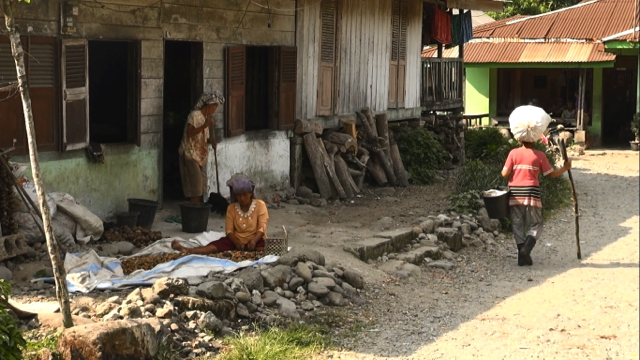
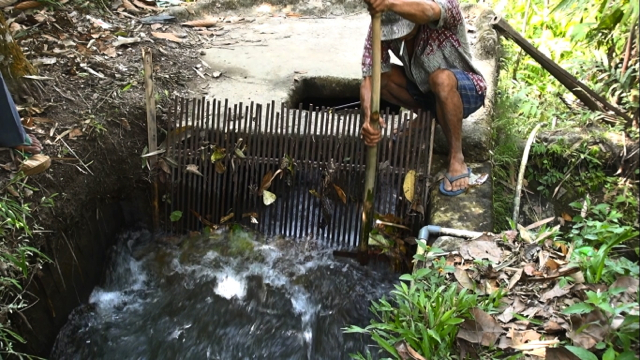
CITATION: Ayat S. Karokaro. “Belajar dari Rumah Kinangkung: Menjaga Hutan Berbuah Listrik.” Mongabay-Indonesia. 21 April 2015.
